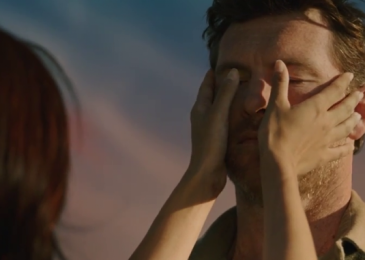The Catholic News Agency has a new story about Jesus VR, the “virtual reality” Jesus movie that was previewed at the Venice film festival earlier this month.
The story revolves around an interview with Motive Entertainment’s Paul Lauer, who has promoted many films to the “faith-based” market including The Passion of the Christ, The Young Messiah and Ben-Hur. Motive is now promoting Jesus VR, too, and some of the things that Lauer says are worth noting and commenting on.
For example:
In a traditional movie-watching experience, the film’s editors control what part of a scene the viewer sees at any moment, but in Jesus VR, “you become the editor,” Lauer told CNA.
This is a striking statement, because for centuries the purpose of religious art has been to focus the viewer’s attention on whatever it is the artist is trying to communicate. Very often the art in question is meant to draw the viewer out of himself or herself — to help the viewer find some sort of transcendence — but not here, apparently.
Here’s another quote:
Ever since The Passion was made, there has been a “Renaissance of faith-based movies,” Lauer explained. He hopes this will be a tool for evangelization, and is marketing the new media toward churches, youth groups and more.
“Jesus VR is a new medium to convey the message,” Lauer said. The message being the Gospel. According to Lauer, Jesus VR utilizes what is “cutting edge technology” to go “where the young people are.”
I really, really don’t like it when people talk about movies being “tools” for something.
Here’s another quote (actually the reporter’s summary of a quote):
The technology doesn’t require as much fancy equipment as one might imagine. In fact, you only really need two things, Lauer said: a smartphone and the special goggles the viewer wears. The goggles come in several different models and with different price tags, some costing more than $100.
They knew this would be cost-prohibitive for many, especially church and youth groups, which is why Motive Entertainment also developed a mass market version made out of cardboard, which can even be personalized with the name of the church. . . .
This wouldn’t be appropriate to use at a Catholic Mass, of course, Lauer noted, but for other Christian churches which do sometimes use screens at their services and during their preaching, Lauer sees Jesus VR as something that “should aid the pastor,” not replace them.
Except the whole point of “virtual reality” is that people don’t share a common screen any more. Instead, each person wears his or her own goggles and makes his or her own “editing” decisions in terms of where to look and when. Is Lauer envisioning a future in which church services look something like the video below?:
Here’s another quote:
The media is very detailed, aiming to be true to how it really would have been, Lauer said. At the Sermon on the Mount for example, “there was still normal life… kids hungry and crying – real life was happening.”
In a scene which depicts Jesus telling the parable of the Good Samaritan, there are details which you’ll only see if you look around or behind you, such as some people watching nearby who end up walking away.
Because we’re so busy, it can be easy to “miss Jesus manifesting in our lives,” Lauer said. They’ve worked even these little details into the film because it “makes for great reflection, for great teaching.”
So you can distract yourself from one of Jesus’ sermons by watching other people get distracted from his sermons. Instead of drawing the viewer towards some sort of divine transcendence, this work of art surrounds the viewer with banality.
To be sure, it is certainly possible to make a point about the presence of the divine and how people often miss it because of banal distractions — entire scenes in Monty Python’s Life of Brian are rooted in this premise — but how can you teach even that lesson if you aren’t encouraging the viewer to focus on what you’re saying?
I hasten to add that I haven’t seen Jesus VR for myself yet, though I certainly hope to at some point. I just have some questions about the “virtual reality” medium and whether it can work as storytelling, let alone as a communal teaching tool.
–
Meanwhile, on a related note, the Hamilton Community News has a profile of André van Heerden, the end-times movie producer who wrote the script for Jesus VR:
Van Heerden, who has worked in various aspects of film and video production for the past 15 years, said it took about a month to develop the script’s original draft, followed by another six weeks accommodating requests for extra scenes or additional parts to scenes.
“Because the producers were looking for a faithful and accurate telling of Jesus’ story, a lot of my writing was research based,” said van Heerden. “I wanted to make sure that I picked the most significant parts but also the moments that could be strung together to tell a complete story. Everything came back to Biblical scriptures and making sure that it lined up with them.”
Jesus VR is expected to hit the market in time for Christmas this year.





